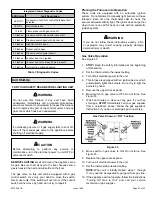
507324-01B
Page 16 of 32
Issue 1809
14. All venting pipe passing through floors, walls, and
ceilings must be installed with the listed clearance to
combustible materials and be fire stopped according
to local codes. In absence of local codes, refer to
NFGC (2223.1 ).
15. No portion of the venting system can extend into, or
pass through any circulation air duct or plenum.
16. Vent connectors serving Category I appliances shall
not be connected to any portion of mechanical draft
systems operating under positive pressure such as
Category III or IV venting systems.
17. If vent connectors are combined prior to entering the
common vent, the maximum common vent capacity
listed in the common venting tables must be reduced
by 10%, the equivalent of one 90° elbow (0.90 x
maximum common vent capacity).
18. The common vent diameter must always be at least as
large as the largest vent connector diameter.
19. In no case, shall the vent connector be sized more
than two consecutive table size diameters over the
size of the draft hood outlet or flue collar outlet.
20. Do not install a manual damper, barometric draft
regulator or flue restrictor between the furnace and
the chimney.
21. When connecting this appliance to an existing
dedicated or common venting system, you must
inspect the venting system’s general condition and
look for signs of corrosion. The existing vent pipe size
must conform to these instructions and the provided
venting tables. If the existing venting system does not
meet these requirements, it must be resized.
















































